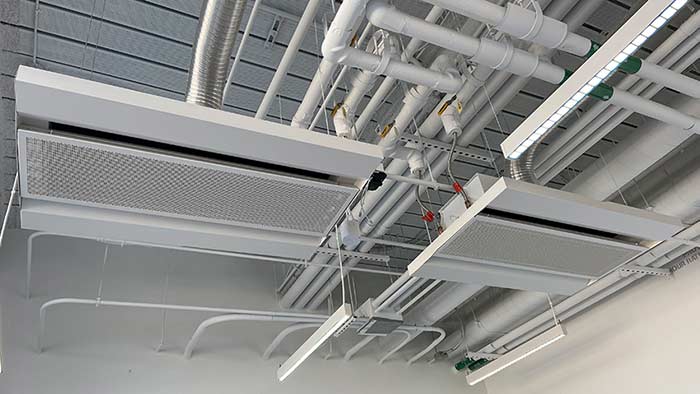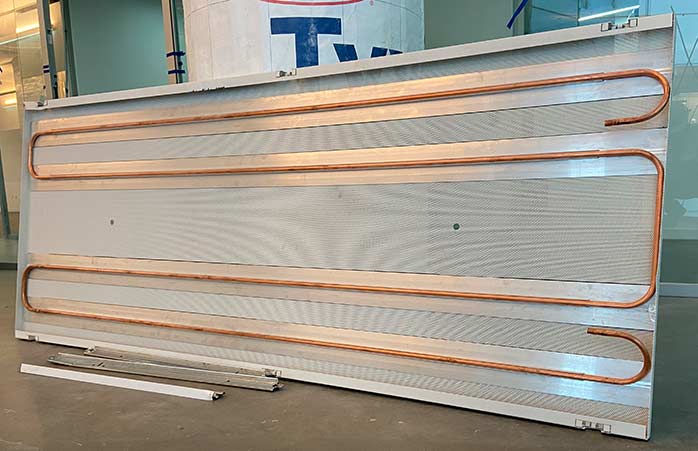A chilled beam system is an HVAC system used to heat and cool large buildings. Since large buildings require large amounts of energy to keep cool, the idea of a chilled beam system is to use natural convection (warm air rises, cool air falls) and the superior energy capacity of water to make cooling much more economical. Warm air rises to the chilled beam, which is located in the ceiling, and passes through a heat exchange coil where it cools and then falls to the floor.
Chilled Beam Energy Savings
Chilled beams provide building owners with significant savings in a number of ways. First, water is a much more efficient energy transport medium because water has a higher density and higher specific heat than air. 1 cubic-foot of water can carry the same amount of heat as 3,000 cubic-feet of air. Therefore, we can move energy in small pipes rather than large ducts.
Chilled beams will cut down on the number and size of fans a building needs, which reduces electricity requirements. Since more energy is moved in water, a water pump can transport more energy than a fan for the same electricity cost. As you will see below, active chilled beams still require fans, but at a much smaller size.
Finally, since chilled beams allow for smaller air ducts, the space above a ceiling can be reduced, which will theoretically reduce the building height. A reduced building height means there will be less of all the building materials, which means the first costs for the building and the energy used to produce those materials may be reduced significantly. Chilled beam technology is still more expensive than other HVAC systems, but since first costs can be reduced an owner may see an immediate payback on the investment.
Passive Chilled Beams
There are two main types of chilled beams - active and passive. A passive chilled beam moves heat strictly through convection. Ventilation air is provided through other means and the air is drawn to the heat exchanger through the natural rise of warm air. Passive chilled beams are silent since there are no fans pushing air through them.
Since there is no air movement generated by the chilled beam, less energy is used. However, the system is less effective at providing thermal comfort. In order to help maintain the effectiveness, the passive chilled beam should be located closer to the occupants, which generally means ceiling heights should be no higher than 8 or 9 feet above the floor. Passive chilled beams are poor at providing heat to a space.

Active Chilled Beams
Active chilled beams improve on the passive version by incorporating an air duct and nozzle blowers that provide ventilation air, which helps draw the warm room air up through the heat exchange coils. This makes the unit more effective at providing thermal comfort for building occupants and allows the unit to be used for heating. In addition, an active chilled beam can be mounted in ceilings as high as 10 feet while still being effective.


Chilled Ceilings
Chilled ceilings differ from chilled beams in that they rely more on radiant as opposed to convective heating and cooling. A chilled ceiling is a metal sheet with water pipes running above it. The pipes heat or cool the metal panel, which then radiates that energy toward the building occupants. Since they rely on radiant properties, chilled ceilings must be aimed at a building occupant to be most effective.


Chilled Beam Advantages
The advantages of chilled beams are covered above, but to review here are the main benefits:
- Quieter than air based HVAC systems due to the lack of moving parts and slower air velocities.
- Maintenance is also reduced due to the lack of moving parts.
- Above ceiling and mechanical room space is reduced, which can reduce floor-to-floor heights. This can decrease first costs to the point where chilled beams see an immediate payback on the initial investment.
- Energy use is reduced since water is more efficient at moving energy than air and there is a reduction in building fan use.
- Drafts are reduced, which increases occupant comfort.
Chilled Beam Disadvantages
This article has focused on the advantages of chilled beams; however there are some disadvantages that need to be taken into account when designing an HVAC system that uses chilled beams:
- Most concerning is the opportunity for condensation forming on the cooling coils and then dripping into the space. Therefore, humidity must be controlled and monitored or other systems should be put in place to turn the chilled beams off when humidity rises.
- The chilled beam system may be more costly when compared directly to an air system.
- Maintenance crews and building management teams may not be as familiar with the system as an all air system.
- Chilled beams are less effective at heating spaces so the building skin must be properly detailed to prevent heat transfer.


